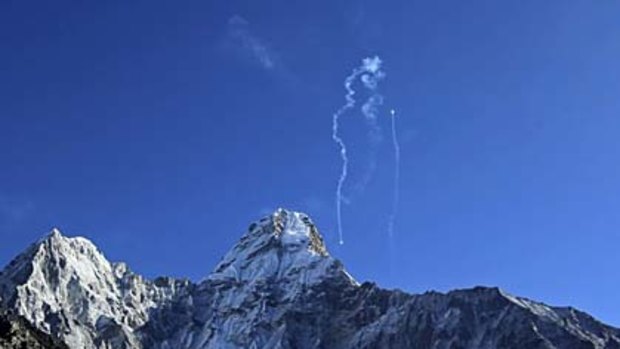By Jane E. Fraser

Peak season ... fireworks are launched at Solukhumnu to mark the launch of Nepal Tourism Year.Credit: AFP
Flightseeing above Everest, eco-resorts and wildlife spotting - who said Nepal was just for climbers? Certainly not the Nepalese, who have ambitious tourism plans.
IT'S an old favourite for Australians, from the hippie backpacker era to today's high-tech trekkers and voluntourists. But Nepal is aiming for a fresh influx of visitors, declaring 2011 Nepal Tourism Year, a campaign aimed at "shaking off all the dust of political uncertainty, strikes and obstructions".
Few in the industry believe the country can achieve its target of almost doubling total visitor numbers to 1 million for the year; however, many new tours and experiences are on offer.
Next month, World Expeditions will begin commercial operations on the Nepalese section of the Great Himalaya Trail, a proposed 4500-kilometre alpine trek on a network of trails through Bhutan, China, India, Nepal and Pakistan.
Four people have already signed up to walk the entire 1700-kilometre Nepal section, which takes about five months, but most travellers are expected to break the trek into seven smaller sectors, to be led by well-known adventurers such as Sorrel Wilby and Greg Mortimer.
"We view the route as an important development in Nepal's tourism as it spreads the tourism dollar to remote and isolated communities," says the chief executive of World Expeditions, Sue Badyari. The trail will take trekkers to some of the most remote mountain areas imaginable. Badyari says some sections of the route will be suitable only for highly experienced trekkers.
Peregrine Adventures, which claims to be the largest operator to Nepal from Australia, says it has experienced 30 per cent year-on-year growth in bookings during the past two years.
The company's Himalaya destination manager, Steve Wroe, believes the numbers can rise even higher now Nepal's political situation has settled down.
"Confidence is back up and
I think we're going to see continued growth for the next few years," Wroe says.
He says Peregrine is not offering the Great Himalaya Trail because it is too remote and expensive to access for short trips but there are many other new experiences. The company recently added Mustang, on the Tibetan Plateau, to its itinerary and has found it popular with travellers returning to Nepal.
Wroe says the Mustang landscape is quite barren - what he describes as "classic monastery sort of views, with prayer flags and rocky outcrops" - and the culture is very much like that of Tibet.
Another new product proving popular is climbing trips on Mount Everest, offered as a four-day extension to the company's Everest Base Camp trips.
Surprisingly, much of the demand is coming from first-time trekkers, a trend Wroe attributes to "icon-driven tourism" and the desire for bragging rights.
Wroe says he has noticed a shift away from trekking in the Annapurna region in favour of the more famous Everest.
However, Peregrine's Annapurna program has been boosted by a community lodges initiative that involves the company identifying villages off the beaten track and providing funds and advice to locals to build lodges. "We've got a couple of treks that use those lodges and the money from the lodges goes back into the local community, so it's a win-win," Wroe says. "The trips that offer those lodges are going gangbusters for us."
At the luxury end of the market, Abercrombie & Kent has reintroduced an 11-night private journey to Nepal, including four nights in Kathmandu, a three-night trek in the Annapurna region, one night in Pokhara and two nights on safari in the Chitwan National Park, near the border with India.
Adventure World, which focuses on soft adventure options, reports non-Himalayan trekking trips are increasingly popular with Australian travellers. Many head to Chitwan to see wildlife such as Bengal tigers and rhinoceros and to experience the jungle.
Adventure World spokesman Craig Gibbons says there is also growing demand from travellers who are keen to explore the cultural side of Nepal, particularly its Buddhist traditions.
Also selling well are Mount Everest sightseeing flights, for those who want to see the mountain without the weeks of preparation and trekking. About $250, the flights are an affordable option for non-trekkers.
Gibbons says the stereotype of hardcore trekking deters many travellers from going to Nepal, yet there is a huge range of tourism experiences, including stays at eco-resorts, at hill stations left behind by the British, as well as at luxury hotels in Kathmandu.
"Most people think it's Everest Base Camp and eating out of a tin but it doesn't have to be that at all," he says.
"It's a country that's really open to all kinds of travellers."
Generosity climbing
VOLUNTOURISM, or volunteer-related travel, has become popular in Nepal, which remains a very poor country. World Expeditions says there is strong demand for its Community Project Travel trips. This year's projects include refurbishing a school and building a medical clinic in the Annapurna region. Habitat for Humanity plans to take 100 Australian women to help build homes for 250 female-headed Nepalese families in March. The organisation says participants will be taken "off the beaten track" to work side-by-side with Nepalese women.
jane@janeefraser.com.au
Sign up for the Traveller Deals newsletter
Get exclusive travel deals delivered straight to your inbox. Sign up now.